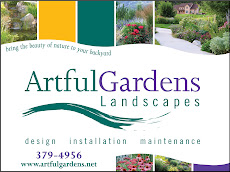Here are just a few common mistakes we see every day:
1. Planting large trees and shrubs too close to the front door, often in that little 4’ walkway garden the builder allowed for. While cute when they’re small, they ruin the appeal and good energy of the entry when they’re full-sized. If you can't see the front door, or must duck under trees to get there, or it is so dark and foreboding no one wants to enter, it needs to be changed immediately! We fix lots of entry gardens that are overwhelming the house.
2. Planting trees too close to the house, smack in the center of window or patio doors, which ruins the look and the view, along with harming the "Feng Shui" and delivering bad energy. There is an art to placing trees so they enhance, shade, and provide some privacy but do not intrude.
3. Planting spruce trees where they will overwhelm the house instead of complement it. How many times in our valley have you seen this look >>>>>>
People forget spruce trees get 40' tall and 40' wide!
4. Making garden beds too small for the scale of the house.
There are dozens of design principles we follow when creating a yard or garden, I’ll cover a few at a time:
1. Framing. Landscaping should frame the house like hair around a face. It should soften the corners, and unify the house with its surroundings. This house has an okay, though undersized, front landscape, but the lack of framing or a background (see #3) makes the house look awkward on it's lot.
2. Scale. Plantings must match scale of house and lot. Nothing looks sillier than a nice-sized house on a large lot with tiny spindly trees. When budget is a factor, we combine small trees in groupings with a few large trees and shrubs for a more natural, balanced look.
3. Background. It’s important to provide a backdrop for the house, with tall trees behind the house which will show and provide perspective from the front. This gives the house a sense of place and highlights it from the street. See how uncomfortable this house looks on it's lot with no background trees? How pretty it would look with an appropriately sized palm tree in the back yard.
4. Balance. Houses are rarely symmetrical. Balancing the house with appropriate landscaping satisfies the eye. Visualize the house set atop a post – which way would it lean? Balance out the “light” side with landscaping by installling a larger garden with larger material on that side.
5. Size. Many homes have outdoor spaces that are not appropriately sized for the house. How big should your outdoor spaces be? Imagine that your house has fallen forward onto its front façade. The imprint it leaves is usually the right amount of ground needed for a garden, patio, porch, or lawn. This is especially important for the front for visual appeal, but on larger lots, you should do the same exercise with the back and sides as well.
6. Creating a Feeling. Looking at a garden should evoke wonderful feelings and memories. It should take you on a mental journey – help you visualize the numerous ways you will use and enjoy the garden over the years – sitting with a book, walking down a path, hosting parties, hearing the happy sound of kids playing.
What kind of feeling does this evoke in you?
How about this?
Stay tuned for more design principles. In the mean time, if you’re not happy with the way your yard looks or feels, call or email us for a consultation! jaeg1@comcast.net









No comments:
Post a Comment